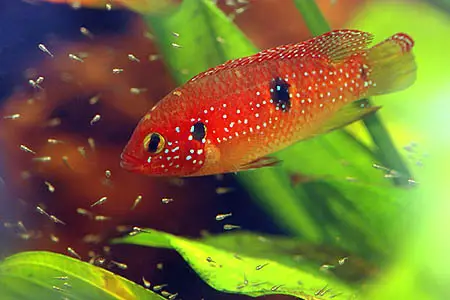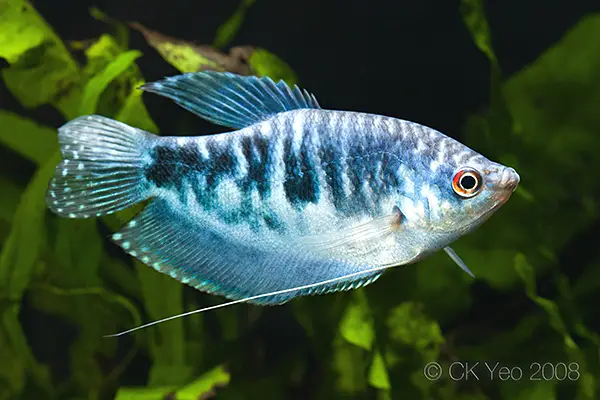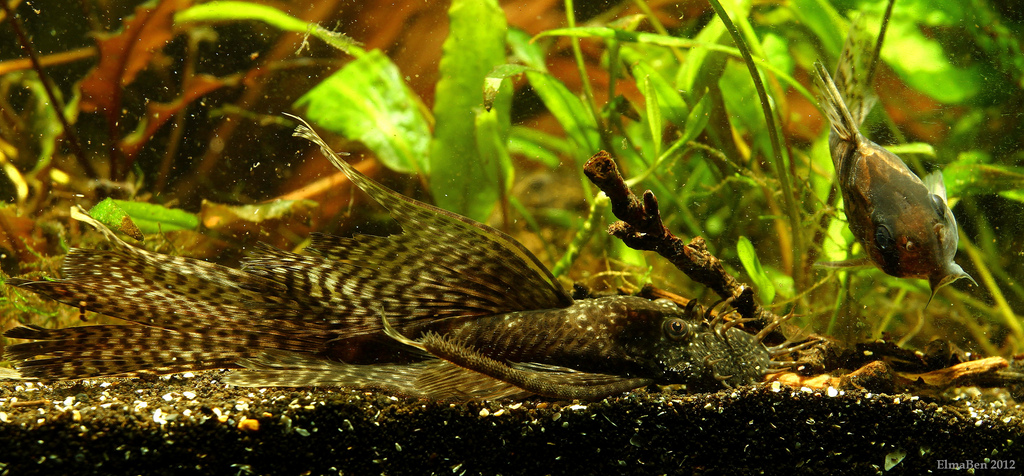 |
Jewel Cichlid Female (H. Bimaculatus) with Fry
SeriouslyFish.com photo |
It occurred to me that even after running the Fish Cave blog for quite a while I've never actually gotten around to compiling a guide on taking care of fish. As it happens, taking care of fish is something of a passion of mine - one I don't mind doing for hours and hours on end. Of the various species it is possible to keep as pets, fish are possibly the most alien to our considerably powerful mammalian brains, and under the right care conditions, I've yet to find a fish in the hobby that wasn't gorgeous in some way, shape, or form. From the grace of a shoal of Dojo Loaches to the visual flattery of Discus, there are very few fishes that inspire a "bleh" reaction from me, and there's certainly the right fish out there for anyone.
Firstly, if you're reading this guide without having bought anything at all yet: great! Research, particularly when it comes to living things, is a great thing. Kudos to you. Hopefully this guide will help, just a little bit, in choosing your build and getting it going. In this article I take it as a given that we're discussing a freshwater, planted aquarium.
Size Matters
There are, frankly, three things to consider when selecting the size of the aquarium itself:
- The Fish you're planning on keeping,
- How well it will fit in the room, and,
- Cycler's Law - larger tanks are chemically more stable than smaller ones.
If you already know what sort of fish you want, it's a good idea to check out sources like aquahobby.com or seriouslyfish.com in order to determine what they require in terms of water volume and tank base size. If you don't know, feel free to ignore that rule, but remember in general that a larger tank will leave more doors open in the future than a smaller one.
Tanks are More than Size
There's more to selecting a tank than what size they are. What sort of lighting are you going to need? Do you need a cover? What substrate should you use? What sort of filter will be best for your fish and your tank size?
The Filter: Your Tank's Beating Heart
Your filter is perhaps the single most important component of an aquarium after the glass itself. A proper filter is going to be circulating your tankwater, converting ammonia to safer compounds, adding motion to the water, and in many cases, oxygenating it. Whether you choose to go with a high-end canister filter or a hang-on-back variety, there are a few general tips I can give:
- Always choose a Hagen product. Both the aquaclear HOB filter and the Fluval canisters are the most resilient enduring, and practical filters I've ever worked with
- Ditch activated carbon on the first media change. Seriously, whenever you finally have to change the filter media, replace your activated carbon package with foam media or a biological substrate like Biomax. I'll explain why in the following section.
- Ensure that your tank size is within the limits of the filter you are choosing, and ensure that all intake and output passages are inaccessible to fish.
A canister is, by design, always more effective than the corresponding grade of Hang On Back filters, but for some well-behaved (read: low-waste) fish, an HOB is more than sufficient for all but the most diehard aquarist.
Concept: Nitrogen Cycle
If you're anything like me, your first thought after hearing the words "nitro-cycle" will be to remember the motorcycle-like penny farthing from Wild Wild West. Unfortunately, the real thing is invisible to the naked eye, but it should not be ignored. If the filter is the beating heart of the tank, than the nitrogen cycle is the circulation it drives.
As fish excrete waste, and as uneaten food and dead plants decay, they give off ammonia (a nitrogen compound), which is toxic to fish. In a properly "cycled" tank, bacteria called nitrosomona actually digest this ammonia and produce Nitrites. Nitrites are less toxic than ammonia, but still pose a risk to fish, and another bacteria, nitrospira, further digest the Nitrites into nitrates, which is (mostly) harmless to fish and actually serves as nutrients for the aquarium's plants. Nitrates do, however, continue to build up, but this problem is corrected with partial water changes.
This cycle can be encouraged with the use of a Nutrafin product called, unimaginatively, Cycle, which is little more than a cocktail of nitrosomona and nitrospira. Even still, establishing a nitrogen cycle takes time, as we will see below.
Lighting
An important part of choosing lighting is going to be staying within the bounds of what your canopy will support. Whether you have a simple light-bar or an actual enclosed tank-top, it's going to be set up for a certain length, type, and wattage of bulb. In general, I try to encourage people to stay away from incandescent bulbs and favor longer-lived (and more versatile) florescent ones... choose your canopy accordingly.
With the exception of some fish which prefer low-light, it's hard to overdo lighting, but it does take some tuning. You need to adjust for the level of plantation, particularly with the Plant-Gro bulb, because unused nutrients are almost always hanging around a tank and an unused amount of energy could result in an inadvertent algae bloom (which is also why we try to keep our tanks out of direct sunlight). These blooms are both ugly and potentially dangerous to fish, but easily averted and easily-enough corrected.
As it happens, I do maintain a few tanks in direct sunlight. I keep the algae level down using what's called a UV filter. The filter sucks water through and zaps it with high-energy UV, killing the algae, which then get eaten up by the proper filter. Between a Fluval canister and this UV filter, one tank under direct sunlight went from being an opaque green to being almost perfectly clear essentially overnight.
Substrate
Most of us are familiar with gravel-bottomed tanks. For many fish this is actually ideal as it prevents them from swallowing up substrate and becoming impacted, but for many other fish gravel is too rough and too large-grained for their purposes. Do your research on your fish, and don't be afraid to mix and match. Personally, I like sandy substrates with "islands" of natural-coloured gravel; I find it looks more natural.
Heating
Always make sure you have a heater rated for the tank size you are using. This should be sufficient to reach any temperature you need, comfortably, and such heating is essential for all but three species of fish that I can think of which are commonly available in the hobby.
Chemicals
As I mentioned in the section on the nitrogen cycle section, you're going to find that the most important parameters of your tank are all going to be absent of your senses and you'll need some help figuring them out and getting them working properly.
The first chemical we need to talk about is a water conditioner - I use AquaPlus - which is for dechlorination of water and usually does a few other things too, like neutralize heavy metals. As a general rule I dose this whenever I add water to a tank, add fish to a tank, or even when I seem to be having white clouds (which is an issue with phosphate content of the water). Early signs of disease? Give it a squirt. Packaging fish for a move? Bet your bottom dollar they get a dose.
We already talked about cycle - a good off-label use for that particular chemical is in attempting to clear up the afforementioned white cloudiness issue, before moving on to an actual phosphate remover. Since this usually works I almost never keep the latter at home and I rarely have to open it at work.
Next comes your test kit. The hard part is selecting one, since not every keeper needs every test, or needs it often enough to have it be part of the main kit rather than an addon. In this respect Hagen makes a very nice range of tests under the Nutrafin brand. At minimum, everyone should be able to test for pH, ammonia (NH3/NH4) and hardness (KH). If you're going to be wandering beyond Swords, Anubias, and Java Fern/Moss by way of planting, having tests for the other two nitrogen-cycle compounds as well as iron and phosphates isn't a bad idea. Test regularly and often. pH adjustment chemicals are encouraged but unnecessary to those with a fundamental understanding of chemistry and suitable caution. Keep the books around, too - some tests are more complicated than you would think, and even without that, you need the charts on the back of the book to reliably interpret the results.
The last chemical we need to talk about right now is salt. Believe it or not, even the freshest setups require a little aquarium salt, and many tropicals we consider to be "freshwater" are actually brackish and require a little marine salt. If you're working with the latter, you'll also need a hydrometer to measure the specific gravity of the water-marine solution.
Putting it All Together
Now that we have what we need, it's time to start putting together the tank. The first step will be to rinse everything in warm water to clear it of dust. At no time should you use surfactants like soap or detergent on anything going in your tank. Wash all components with warm water before construction and wash all decorations before adding them (any "found" decorations like rocks or driftwood should be vigorously boiled to sterilize them).
Assembly is going to vary according to specific parts, so in that respect I defer you to the manuals, with the strong caution not to add water until the tank is positioned exactly as you want it. Add room-temperature, conditioned water (and do so slowly in order to avoid disturbing your substrate and requiring you to wet-rescape). Allow the filter to run the water through overnight, which should eliminate the clouds caused by stirring everything up.
Now the waiting begins. A nitrogen cycle can take a few weeks to establish, during which you should still feed the empty tank. Watch the ammonia go up daily and wait for it to crash back down to zero. During this time, it's also possible to adjust the salinity and acidity of the water to suit the tastes of the fish you're considering. If you still aren't sure what fish you want, steer toward 7.0 pH, with as low a hardness (KH) as you can managed, at a temperature of 76-78 Fahrenheit. This is a "neutral" starting point for most species of tropical and a common set of water parameters for community tanks. Obviously, if you have fish picked out already, now's a good time to get the parameters down to what they like.
After the nitrogen crash, begin planting, which will start the nitrates being eaten up. It is now okay to begin slowly introducing fish to their new home. As a general rule I try never to add more than 10 "small" fish at once (such as tetras, livebearers, etc) and I usually count feature fish (sharks, discus, cichlids, large tetras, labyrinth fishes, and so forth) as two or three depending on their size.
Allowing the full time to elapse between first adding the water and establishing the nitrogen cycle should keep your fish as happy as possible and minimize your losses. Always remember that some pet salespeople are salespeople first and pet-keepers second, and that nobody knows every animal; cycle your tank. If someone tells you that a given fish could handle living through the cycle, remember two things: they might actually be right, and that's a bad thing.
You're more than a haver of fish. You're a fish-keeper, responsible for their wellbeing and longevity. I can't think of an aquarium fish with a captive life of less than three years and I can think of at least five species I know of that live longer than 20, in the proper conditions. Fish are alive, and just like how you would never abuse a dog or abuse a baby, you should never abuse a fish.
 As it turns out, Mongkut is a bit of a mug. I was nervous of him a bit at first, because he was exhibiting a tendency to flare at the walls of his ten-gallon tank, and was reluctant to eat the food I was intent to feed him. Now he eats voraciously and is rather placid. I'm considering getting him some other tankmates once I solve a few small financial problems.
As it turns out, Mongkut is a bit of a mug. I was nervous of him a bit at first, because he was exhibiting a tendency to flare at the walls of his ten-gallon tank, and was reluctant to eat the food I was intent to feed him. Now he eats voraciously and is rather placid. I'm considering getting him some other tankmates once I solve a few small financial problems. 








